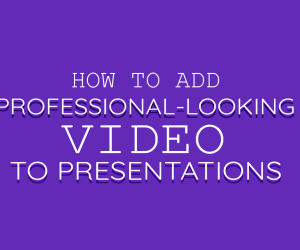
Description: Presenting slides for an interview can be nerve-racking. Especially if you aren’t good with people or it’s a big deal on the line. Not to worry, read on to get helpful tips to know before presenting.
Presenting an interview using slides to a prospective client can be a little daunting. Things can go wrong as a recruiting agency looking to sell their services or idea to the company. It may not be an external presentation but an internal one, maybe for a promotion. Regardless of why you are presenting, the main point is you cannot afford to mess up in front of your audience. Well, you are in luck – in this article, you w+ill learn some helpful tips to imbibe and potential pitfalls to avoid when presenting.
Know Your Audience And Equipment
This point is self-explanatory, and it is also one you can overlook if you are not mindful. Before you tackle a topic, you should know the people that you will speak to on the day. Getting information such as names, positions held in the company, and expertise will give you an edge on how best to prepare for them.
Industry experts may understand more technical terms and happenings, while those less familiar with the recruiting industry may struggle with some concepts. The aim is not to lose your audience. So it’s best to know them, so you know the language you use while speaking.
The other thing to be conscious about is the equipment. If you are presenting at an office, ask about their equipment (projectors, laptops, internet connection, etc.)
If they provide a system, find out what version is the operating system? Also, find out if they have steady access to the internet if you will need it for a cloud-based presentation. Doing all of this will prepare you for the task ahead, and it also helps with your confidence, knowing what you are going to encounter.
Format of the presentation
Having a format is key to delivering a successful presentation, and a splendid arrangement also helps guide you when delivering the presentation to the audience. Ideally, your presentation should have three broad aspects, the introduction, the message or body, and the conclusion. This format gives your presentation structure and guides your execution when speaking. Aside from the shape your presentation should take, note some of these vital points when presenting.
- Keep your slides short and easy – ideally, one point per slide.
- Don’t write all you want to say on your presentation slides, and the display is more of a summary of the point you raise.
- Learn what you want to present by heart. The better you know what to say by heart, the easier it will be to explain yourself. Use your display as a guide.
These are some tips to use when presenting.
Format of the slides
The structure is essential. But so are the font, clip arts, and template used too. While having a great format may be good for you, the recruiter, the first impression for your audience is your slides. A visually unappealing display may turn off your audience before you have the chance to impress with the content.
So some tips to keep in mind when presenting.
- Simple Templates: Don’t overcomplicate matters by using one of those fancy templates provided by the application you use. If you are using PowerPoint, don’t bother. Most people in the room must have seen all the templates already. Go for a simple white template. It keeps things nice and clean.
- Diagram and Pictures: The use of pictures or graphs to reinforce your argument is acceptable, making it easy to digest and summarize your argument. Avoid using uncreative and outdated clip art or animation – doing that will take away the beauty of your presentation. We recommend using Shutterstock for high-quality images and pictures.
- Font: When choosing your font, consider two things. The first is the font size. Typically, go for two font sizes; One for the heading and the other for the body. Make sure it’s bold and big enough for people to see and read. The next one is the font type. There is the temptation to be stylish with your font but resist this. Go with a clear font, do not slant it, and make sure it’s a style most people are familiar with. That way, it’s easy for them to read.
If you are finding it challenging preparing your slides, you can find the contacts of a talented presentation creator.
Get Interactive with the Audience
When presenting, try not to make it a monologue. There are ways to get your audience engaged with your presentation. An appropriate place to start is to make them think alongside you. You can use a popular or recent industry event to buttress a point or ask questions you know they will probably know the answers to. The aim is to exchange them, make them realize what you are saying as you take them through your slide displays.
Engaging the audience with words is only half of your presentation, and the other half is your body language. How you speak, the way you carry yourself in the meeting, the eye contact you make, and the movement of your hands also play a role in engaging the audience. Below are some tips you can use:
- Speak clear enough with confidence: Try not to be too fast or too slow – as you speak, you will notice the best rhythm that works for your audience. A good time to pause while speaking is when explaining key points, and pausing can help the audience absorb what you say.
- Let your eyes be on people: It’s convenient to focus on nothing when talking, but for a good engagement, look at people. Let your eyes move from one person to another while speaking. Make sure you read their faces, making sure they understand what you are saying and are relaxed.
- Try to smile occasionally: Smiling is an excellent way to tell your audience you are comfortable with them, and to a large extent, you are confident. Smiling also presents you as friendly and trustworthy, two traits that will benefit you in your presentation.
- Stand well while talking: Your posture tells your audience a lot. Stand upright and not slough. Your shoulders should be at your back and take steps intermittently.
These are ways to interact with your audience to execute a good presentation.
Proof Read
A poor grammar, spelling error, or incoherent sentence can mark you as unprofessional. It is one activity that most people know about, but it’s best to take it seriously. Proofreading and getting a friend or someone else to proofread again is an excellent choice.
Practice Practice Practice
This point goes without saying, but practice your argument, presentation style, and time yourself while at it. The company or management will probably give you a time limit, and you should make sure you have enough time to go through all of your points. Practicing makes you more confident in yourself and what you say, and it also helps calm your nerves, knowing you have put in the effort.
In conclusion, a recruiter can win an interview presentation by ensuring the proper slide template, fonts, and structure are in place. But they must not rely on that alone and note other critical factors like engaging their audience, arriving on time to check the right equipment, and proofreading what they intend to share. These, including getting good practice and rest before the interview day, will help the recruiter.



